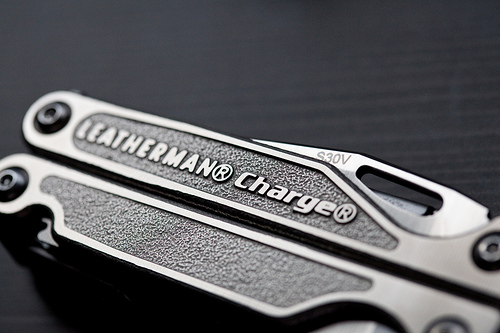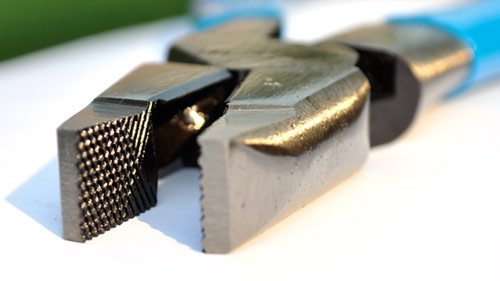
We have a reader who is very fervent about purchasing American made tools. He likes to say stuff like “You forgot, this (darn product) is made in Red (non-democratic country), you (insert derogatory name calling)”. He argues that purchasing these tools takes jobs away from hard-working Americans. Well that got me thinking- what qualifies as American made and what companies meet that criteria?
Marketing Lingo
I remember learning about some sneaky marketing tactics used to sell juice. Eventually, the FDA caught on and set down some very specific rules regarding the appropriate terminology and implied messages for juice sellers. Here’s a few excerpts from the FDA Food Labeling Requirements:
- If the beverage contains fruit or vegetable juice, the percentage shall be declared by the words “Contains _ percent” juice
- If the beverage contains 100 percent juice and also contains non-juice ingredients …. it must be accompanied by the phrase “with added ___,”
- If the labeling or color and flavor of the beverage represents, suggests, or implies that fruit or vegetable juice may be present …. then the label shall declare “contains zero (0) percent (or %) juice”.
So I started researching what guidelines exist for the claim “Made in America” and here’s what I found.

What Does “Made in America” mean?
Just like the FDA, the FTC has set down standards for the advertising or labeling claim of “Made in America”, even covering suggestive messages like depicting the American flag. If you’re interested, here’s a good read from the Bureau of Consumer Protection with full details. This is my quick summary:
Unqualified claims that a tool is “Made in the USA” means that “all or virtually all” significant parts and processing are of U.S. origin and the products contain no foreign content – even if the percent is negligible. You need to pay close attention to the verbiage as this is different from qualified claims like “Manufactured in the USA from foreign materials” or “Assembled in the USA”.
Verifying Tools that are Made in the USA
The big question is what tool manufacturers live up to the claim. I searched around and started verifying a few manufacturers. You may be surprised with what I found.
- Leatherman
The Leatherman headquarters has been located in Portland, Oregon for over 25 years. That’s also the location of their factory but they cannot claim their products are “Made in the USA”. Here’s the reason (direct from their site):These Leatherman tools were all built and assembled by U.S. workers at U.S. factories using primarily parts made entirely in the United States and some parts processed, in part, in Western Europe, Mexico, or Canada. Unfortunately, Leatherman is not able to procure all of its component parts in the United States because of quality, technological, or economic considerations. But Leatherman Tool Group has never shipped a job overseas, and the company remains committed to keeping and creating as many jobs here as possible.
- Klein Tools
Klein Tools operates nine plants in the US in addition to a plant in Mexico City. They make this information very obvious on their website, including the following statement:Klein Tools de Mexico has operated a plant in Mexico City since 1970. This plant produces products for the Mexican and Central American markets. A few tools that are made here are sold in the US, like our knockout punches, but for the most part Mexican made products are consumed in Mexico.
Klein Tools has never closed a US plant and outsourced manufacturing to other countries – and we have no plans to do so.
Klein Tools does sell some products that are made in other countries to our quality standards. For the most part, these are items that are simply not produced in the US any more – a good example is electronic products like multimeters.
So, you can rest assured that Klein Tools remains firmly committed to US manufacturing and continues to invest in the latest technologies for our US production facilities.
- CHANNELLOCK
Channellock has a great “factory tour” of the entire process called From Steel to Shining Steel. It describes how every Channellock product starts as high-carbon, North American steel. It’s an impressive video that leaves no doubt that these products are Made in America.

What do you think? What tools do you know are Made in America?
Images courtesy of Brian.ch and lindsayshaver







I know some folks who would take exception to the fact that we don’t consider tools made in Mexico, Canada, or any other country in this hemisphere to have been made “in America” … Because they ARE. We tend to forget we’re not the only “Americans” here in the U.S. We should probably change the verbiage altogether, or else embrace our grouping (since we DO frequently take advantage of cheaper labor to our south) more like the European Union does.
@Kim, Even after researching this, it’s still a gray area. For instance, Klein Tools has “Made in USA” on their website but admits to plants in Mexico and other countries. That doesn’t jive with the settlement Black & Decker made with the FTC over some locks assembled in Mexico.
I’m not sure how countries like Mexico / Canada affect the “Made in USA” claim. Anyone else want to jump in here? What am I missing?
I’d love to purchase tools made in Canada and the USA, but the economics usually is against it. Especially for big tools like tablesaw etc., they’re usually 2 or 3x the price, of course with higher quality.
Maybe if everyone would get on board to Buy American this country wouldn’t be in the shape it’s in. Remember Ford Motor Company didn’t take any tax dollars to stay afloat and I think this company deserves to be considered anytime an American is buying a new car or truck.
Mike, I do agree with this sentiment. I think Ford has made some strong progress on their technology and brands to try to match some of the imports. The US is a tough place for manufacturing. The reality is that basic labor costs in the U.S. are high compared to elsewhere in the world. Much of what we have exported to China and Indonesia is there because labor is cheaper there…. primarily because those countries are just not as advanced as the U.S. (poorer infrastructure, education systems, etc).
Now, I’ll grant that the products manufactured in these countries are *sometimes* sub-par, but not always. For example, Apple’s widely-successful iPhone and iPad products are designed in America but built overseas to be cheaper…
I think as other countries begin to catch up with the U.S. in technology, we will see some manufacturing staying closer to home, because the advantages of exporting will be outweighed by the transportation and communication costs. Of course, when those countries catch up, our exponential standard of living is going to begin to settle down… so from a selfish perspective it’s tough to know whether we really want that to happen.
Lots of complexities in this topic…
@Kim, give me a break. Canadians and Mexicans do not want to be called Americans any more than we want to be called Canadian or Mexican. We’re Americans. They’re Canadians or Mexican. Maybe you should go hang out with Bush and his NAFTA cronies.
I find that there are 4 types of US companies out there today, in terms of USA manufacturing.
There are those that abandoned factories in the USA in seek of lower costs and greater profit margins, e.g. Irwin.
Then there are the companies that shift manufacturing overseas and try to spin things differently with marketing phrases such as “assembled in the USA”, e.g. SOG.
Then there are the companies I prefer to do business with, those that maintain USA production as a matter of principle, tradition, or pride.
In my opinion, it is also reasonable for a company to contracts manufacturing overseas when they don’t have existing facilities or equipment here. Channellock does this with their screwdrivers and nut drivers. These companies (especially Channellock) take a stance of open and honest disclosure. If you look at Channellock’s website, you’ll see where each and every tool is made.
I don’t limit myself to USA-made tools, but it is definitely something I consider when buying new tools. I also consider companies and their actions. Irwin, for example, shifted production of Vise-Grip pliers overseas, but prices stayed the same.
The complain I often see is that tools and other products made in China are of inferior quality. I don’t think this is necessarily the case any more. That being said I still try to buy US made for economic and environmental reasons (shipping stuff halfway around the world is not environmentally friendly).
Sadly I don’t know of any hand power tool manufacturers that still make their products in the US. But with some research I’ve been able to find hand tools, bits and blades that are still made in the US. Estwing hammers (sadly no longer carried by Lowe’s). Whiteside router bits are of fantastic quality and on par price wise with other high quality bits. From some of the stories I’ve read online they have absolutely fantastic service as well. Forrest saw blades are some of the best around. Not cheap but very high quality. Multiblades.com sells some excellent high quality blades for oscillating multi-tools of various models. Very glad I discovered these as they’re significantly less expensive than the German made Fein blades and in my experience cut better! A real win win there. I was concerned now that I’ve started seeing more and more Channellock tools made overseas but it’s good to know some of the reasons and the fact that they’re open about it.